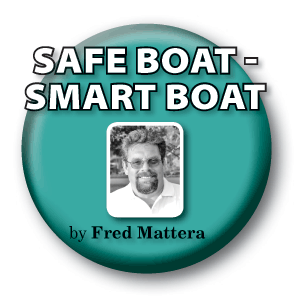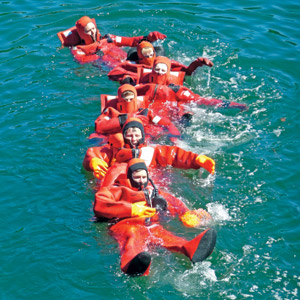The following is Part 2 of a column that began in the last issue. To see Part 1, view online here, CFN May, 2015.
—Editor
The Coast Guard Authorization Act of 2010 requires the Coast Guard to prescribe and develop, in cooperation with the commercial fishing industry, Alternate Safety Compliance Programs.
The 2010 Act added a new Subsection (d) to 46 USC 4503.
Therefore, owners of commercial fishing vessels, tenders, and/or processors – anywhere in the US – that operate outside three nautical miles, need to be aware of what ASCP means to them.
Doing nothing by playing ostrich and burying your head in the sand will cost you a lot of money, time, and extended aggravation.

A qualified Coast Guard-approved marine drill instructor, Fred Mattera of Point Judith, RI is the owner/president of North East Safety Training Co. (NESTCo), which conducts fishing vessel drills and inspections and basic safety training workshops.
Industry leaders and directors of fishing associations will need to unite in their respective fishing regions to form a direct leadership role in the development of an ASCP for their fisheries.
Who is affected?
Which vessels need to enroll in ASCP?
Here’s your answer:
- Vessel is 50’ or greater overall in length;
- Commercial fishing vessel, tender, and/or processor 25 years of age (or older) in 2020;
- Vessel that operates beyond three nautical miles from shore;
- Vessel that operates with more than 16 POB (people on board) inside three nautical miles from shore will also need to enroll;
- Vessel built on or before July 1, 2013, and undergoes a substantial change to the dimensions of, or type of vessel (change in fishery), or completes a major conversion after the program is prescribed (prescribed date 2017);
- Fishing companies with more than 30 ASCP vessels have a compliance deadline of January 1, 2030; and
- Vessels presently less than 25 years old, when you must be in compliance with ASCP. Which means: vessel is 50’ or greater and fishes three NM from shore. Then go to the date the vessel was built and add 25 years. (Example: vessel built in 2005 then you must be in compliance with ASCP by the year 2030).
Compliance timeline
The projected timeline for ASCPs must be prescribed by the Coast Guard by January 1, 2017 and implemented by 2020.
It is my belief that in 2015 the Coast Guard is currently developing tools, such as a risk-based matrix and vessel checklist for fisheries and region. In 2016, form Regional Workgroups to develop ASCPs.
By January 1, 2017 they will prescribe ASCPs, and major conversions must comply as well.
Finally, on January 1, 2020 vessels enrolled must comply with their custom-designed ASCP. Exception for fishing companies with 30 or more ASCP vessels who must comply by January 1, 2030.
The objectives?
Recommended objectives of ASCPs include:
- Reduce vessel losses, fatalities, and serious injuries.
- Address specific risks within a fleet and not simply adopt standards from other programs (recognition that one-size doesn’t fit all).
- Determine whether existing best practices if adopted fleet-wide are sufficient to meet ASC objectives.
- Leverage new technologies as a means to reduce risk.
- Consider geographic and marine infrastructure limitations.
- Identify and dedicate resources to implementing and maintaining the program.
- Consider economic impacts to vessel owners
Addressing the cost
For many fishing vessel owners, financial assistance toward implementing these measures will be vital.
Where will this financial assistance derive from?
Does the federal government possess the willpower to provide low interest funding, or direct assistance funding to improve our aging fleet?
Will capital construction funds be utilized, and will there be tax incentives?
The economic impact should not be a means of forcing consolidation, once again.
This program should evolve over time, by initially addressing the major objectives and adding additional objectives in stages (possibly every three years) to lessen the economic hardship.
Our industry provides healthy, high protein, locally caught seafood for the consumer, as do farmers all across the country.
The US Dept. of Agriculture (FDA) always supports and makes available funds for the farmer. It is time for our congressional delegations to step up and preserve our coastal communities by granting funding to help defray costs of the ASCP program.
Specifics will vary
This is not a one-size-fits-all program. Here’s how regional and fishery specific program requirements may be determined:
- By forming regional workgroups based upon fisheries, geographic location, and common risk;
- By utilizing NIOSH and Coast Guard data to assess regional and fisheries risk factors;
- By evaluating marine casualties (vessel and personnel) based on gear type, fishery, and geographic region;
- By evaluating risks (both evidence-based risks measured in studies and also risks perceived by industry that have not been measured);
- By prioritizing job hazards; and
- By developing program requirements that address those hazards using the ASCP matrix as a tool.
For all vessels
There are some highly suggested ASC standards for all vessels enrolled, including:
- Review casualties and prioritize risks;
- Maintain the watertight and weathertight integrity of the vessel;
- Have a plan for the use of PFDs and the prevention of falls overboard (a fall overboard, while not wearing a PFD, is the most common fatal event in commercial fishing);
- Vessels with EPIRBs should upgrade to GPS EPIRBs when servicing or batteries are due (good example of leveraging new technology to reduce risk);
Starting today
What should vessel owners be doing now?
Here’s a good list to get you started:
- Discuss ASCP at fisheries association meetings;
- Develop outreach to fishermen to heighten their awareness of the ASCP requirements;
- Begin to develop risks assessed in your fishery and identify what are the best practices to reduce identified risks;
- Call the Coast Guard fishing vessel examiner if you are planning a major conversion or changing fisheries for a vessel 50’ or greater overall; and
- Unite the industry through regional fishing associations and take a proactive approach by establishing a partnership with the Coast Guard, naval architects, boatyards, marine engine companies, etc. to provide an important and efficient channel of communication using key and knowledgeable industry leaders.
The Coast Guard may find it difficult on its own – given the size and geographic distribution of the fisheries – to conduct the type of forum and ASCP development that is needed to serve industry.
Most importantly, we need them to finalize and provide a risk-based matrix and checklist of items that the Coast Guard is going to be interested in considering in the program.
Then it’s my interpretation that the fishing industry can review their risks, the checklist, and acknowledge what applies to that fishery in their working environment and what may not.
Once this is established, you present it to the Coast Guard, and you begin the bargaining process.
In my view, fishing industry, it is time to unite and identify the potential flaws and difficulties of implementing ASCP, including:
- Funding;
- Compatible fisheries;
- Ethnicity in the fisheries (language barriers);
- Boatyard availability;
- Naval architects available, (for stability/inclination testing); plus
- Equipment available, repairs, and compliance timeframe, etc.
Is this realistic for thousands of vessels and 50 or more ASC programs?
Answer: We are already losing vessels and fishermen, essentially due to an aging fleet.
We need to do better.
For the first time, our fishing industry has the opportunity to develop our own custom-designed plan to preserve and protect the vessels and crewmembers in our extended fisheries community.
Want more articles and columns that matter to fishermen?
Get a Print edition of CFN mailed to you. PRINT
Quickly enjoy online access with our flip-book. ONLINE
(Read online immediately with access key and download a copy. Not sure?)
Save Big when you Subscribe!








 Updating...
Updating...